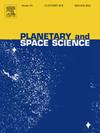月球风化模拟物(FJS-1)和CaF2混合物的热电化学性质
IF 1.7
4区 物理与天体物理
Q3 ASTRONOMY & ASTROPHYSICS
引用次数: 0
摘要
要将月壤的电化学还原过程建立为月球就地资源利用技术,关键是要制备一种具有适合电解成分的高温电解熔体。在这项研究中,我们提出了一种混合熔体,由月球风化层和CaF2组成,其中包括金属氧化物化合物,CaF2可以从月球表面的氟磷灰石中收集。为了表征月球风化层-CaF2体系,研究了月球风化层模拟物(FJS-1)和CaF2的混合物的热学和电化学性质。对FJS-1和CaF2的不同组分进行差热分析,FJS-1:CaF2 = 90:10 wt%时共晶温度为1275 K,低于FJS-1的熔点1393 K。通过电化学阻抗谱技术,FJS-1熔体在1673 K时的电阻为43 Ω,而FJS-1和CaF2的混合熔体(80:20 wt%)的电阻为5 Ω。对固化熔体的XRD分析表明,混合熔体具有独特的物理性能是由于CaF2与FJS-1形成了F−离子和金属离子的化学键。此外,对混合熔体的电化学行为进行了研究,证明了FJS-1衍生的Si和Al等金属的电沉积。报告的数据将为设计月球上的电解系统提供新的指导方针,扩大控制温度和电化学操作的可能性。本文章由计算机程序翻译,如有差异,请以英文原文为准。

Thermal and electrochemical properties of a mixture of lunar regolith simulant (FJS-1) and CaF2
To establish the electrochemical reduction process of lunar regolith as an in-situ resource utilization technology on the Moon, it is crucial to prepare a high-temperature electrolytic melt that has a composition suitable for electrolysis. In this study, we propose a mixed melt consisting of lunar regolith, which comprises metal-oxide compounds, and CaF2, which can be collected from fluorapatite on the Moon's surface. To characterize the lunar regolith-CaF2 system, the thermal and electrochemical properties of a mixture of a lunar mare regolith simulant (FJS-1) and CaF2 were investigated. The differential thermal analysis curves measured for various compositions of FJS-1 and CaF2 found that the eutectic temperature was 1275 K at FJS-1:CaF2 = 90:10 wt%, which is lower than the melting point of FJS-1, 1393 K. By electrochemical impedance spectroscopic technique, the electrical resistance of the melts at 1673 K was found to be 43 Ω for the FJS-1 melt, while the mixed melt of FJS-1 and CaF2 (80:20 wt%) was found to be 5 Ω. The XRD analysis of the solidified melts revealed that the mixed melts' unique physical properties were due to the formation of chemical bonding of F− ions due to CaF2 and metal ions due to FJS-1. Furthermore, the electrochemical behavior of the mixed melt was investigated, demonstrating the electrodeposition of metals such as Si and Al derived from FJS-1. The reported data will provide new guidelines for designing electrolytic systems on the Moon, expanding the possibilities for controlling the temperature and electrochemical operations.
求助全文
通过发布文献求助,成功后即可免费获取论文全文。
去求助
来源期刊

Planetary and Space Science
地学天文-天文与天体物理
CiteScore
5.40
自引率
4.20%
发文量
126
审稿时长
15 weeks
期刊介绍:
Planetary and Space Science publishes original articles as well as short communications (letters). Ground-based and space-borne instrumentation and laboratory simulation of solar system processes are included. The following fields of planetary and solar system research are covered:
• Celestial mechanics, including dynamical evolution of the solar system, gravitational captures and resonances, relativistic effects, tracking and dynamics
• Cosmochemistry and origin, including all aspects of the formation and initial physical and chemical evolution of the solar system
• Terrestrial planets and satellites, including the physics of the interiors, geology and morphology of the surfaces, tectonics, mineralogy and dating
• Outer planets and satellites, including formation and evolution, remote sensing at all wavelengths and in situ measurements
• Planetary atmospheres, including formation and evolution, circulation and meteorology, boundary layers, remote sensing and laboratory simulation
• Planetary magnetospheres and ionospheres, including origin of magnetic fields, magnetospheric plasma and radiation belts, and their interaction with the sun, the solar wind and satellites
• Small bodies, dust and rings, including asteroids, comets and zodiacal light and their interaction with the solar radiation and the solar wind
• Exobiology, including origin of life, detection of planetary ecosystems and pre-biological phenomena in the solar system and laboratory simulations
• Extrasolar systems, including the detection and/or the detectability of exoplanets and planetary systems, their formation and evolution, the physical and chemical properties of the exoplanets
• History of planetary and space research
 求助内容:
求助内容: 应助结果提醒方式:
应助结果提醒方式:


